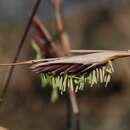en
names in breadcrumbs


Fargesia is a genus of flowering plants in the grass family.[3] These bamboos are native primarily to China, with a few species in Vietnam and in the eastern Himalayas.[4] Some species are cultivated as ornamentals, with common names including umbrella bamboo and fountain bamboo.[5][6]
They are medium to small mountain clumping bamboos, native to alpine conifer forests of East Asia, from China south to Vietnam and west to the eastern slopes of the Himalayas. They are known in Chinese as jian zhu (Chinese: 箭竹; pinyin: jiànzhú), meaning "arrow bamboo".
The scientific name was given in honour of the French missionary and amateur botanist Père Paul Guillaume Farges (1844–1912).
Fargesias are some of the world's hardiest bamboos, but they do not spread vigorously. Common bamboos in the genus Fargesia are essential foods for giant pandas, and large-scale flowering of its species has had a devastating effect on panda populations. Giant panda habitat will therefore need at least two species of Fargesia, to ensure food supply during flowering events.[7][8]
Because fargesias are becoming more well known for their thick clumping habits, they have become cheaper and available at many nurseries.
There are currently about 80–90 recognised species, but morphological and genetic analysis suggest transferring many of these to the genera Thamnocalamus, Yushania and Borinda. Others are still of unknown relationship.[9] As of June 2021, Plants of the World Online accepts the following species:[1]
Fargesia is a genus of flowering plants in the grass family. These bamboos are native primarily to China, with a few species in Vietnam and in the eastern Himalayas. Some species are cultivated as ornamentals, with common names including umbrella bamboo and fountain bamboo.
They are medium to small mountain clumping bamboos, native to alpine conifer forests of East Asia, from China south to Vietnam and west to the eastern slopes of the Himalayas. They are known in Chinese as jian zhu (Chinese: 箭竹; pinyin: jiànzhú), meaning "arrow bamboo".
The scientific name was given in honour of the French missionary and amateur botanist Père Paul Guillaume Farges (1844–1912).
Fargesias are some of the world's hardiest bamboos, but they do not spread vigorously. Common bamboos in the genus Fargesia are essential foods for giant pandas, and large-scale flowering of its species has had a devastating effect on panda populations. Giant panda habitat will therefore need at least two species of Fargesia, to ensure food supply during flowering events.
Because fargesias are becoming more well known for their thick clumping habits, they have become cheaper and available at many nurseries.